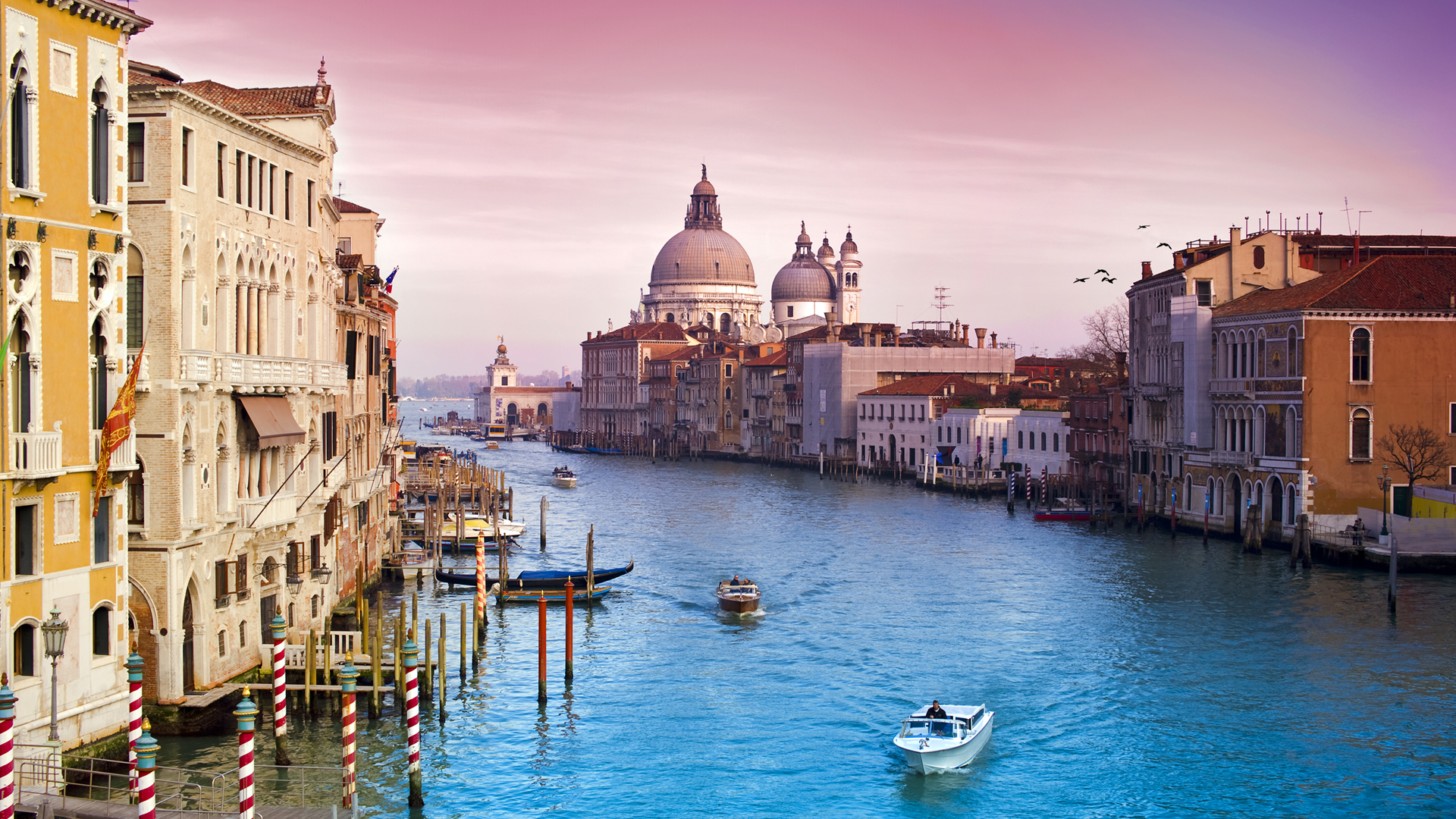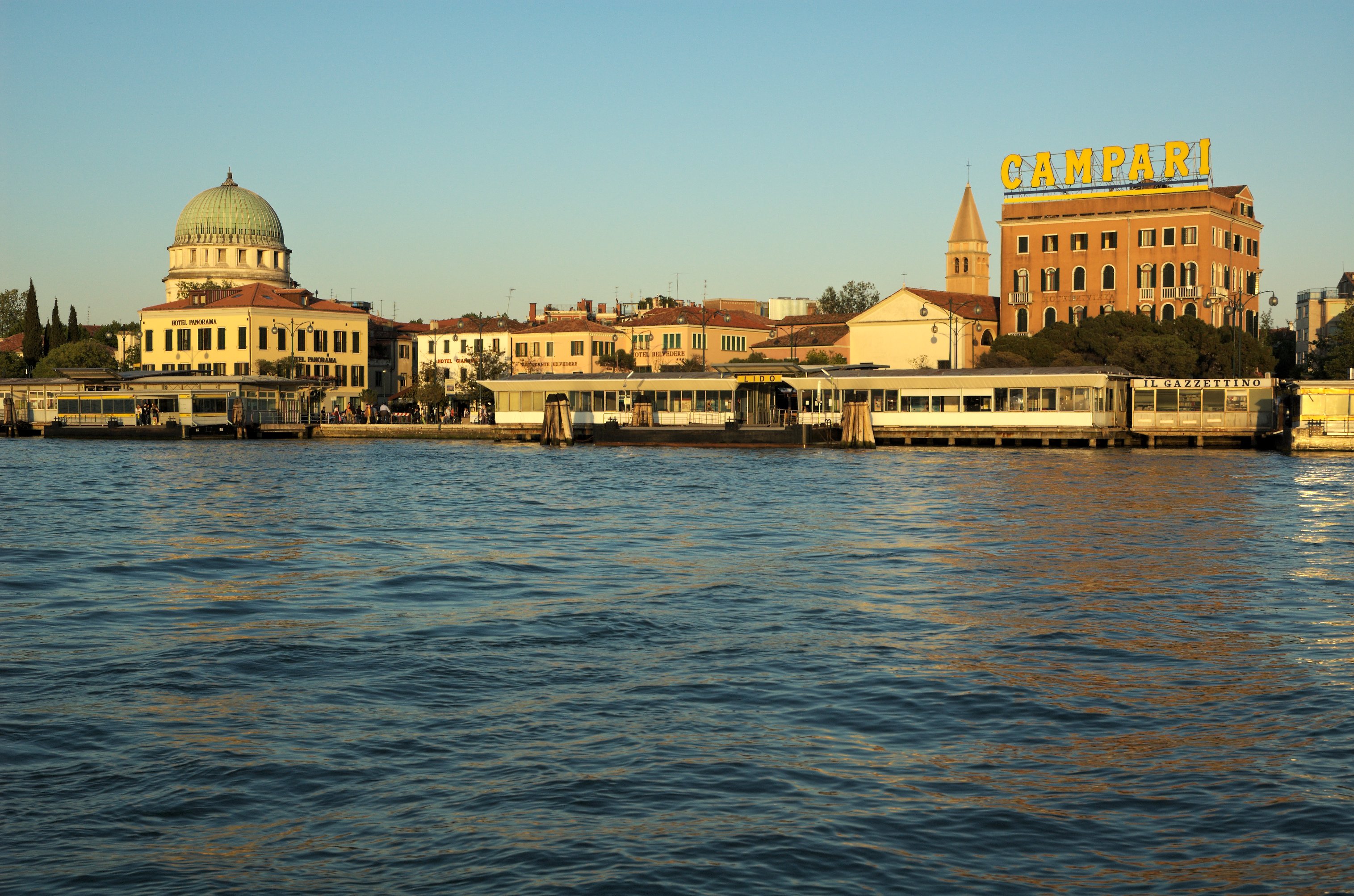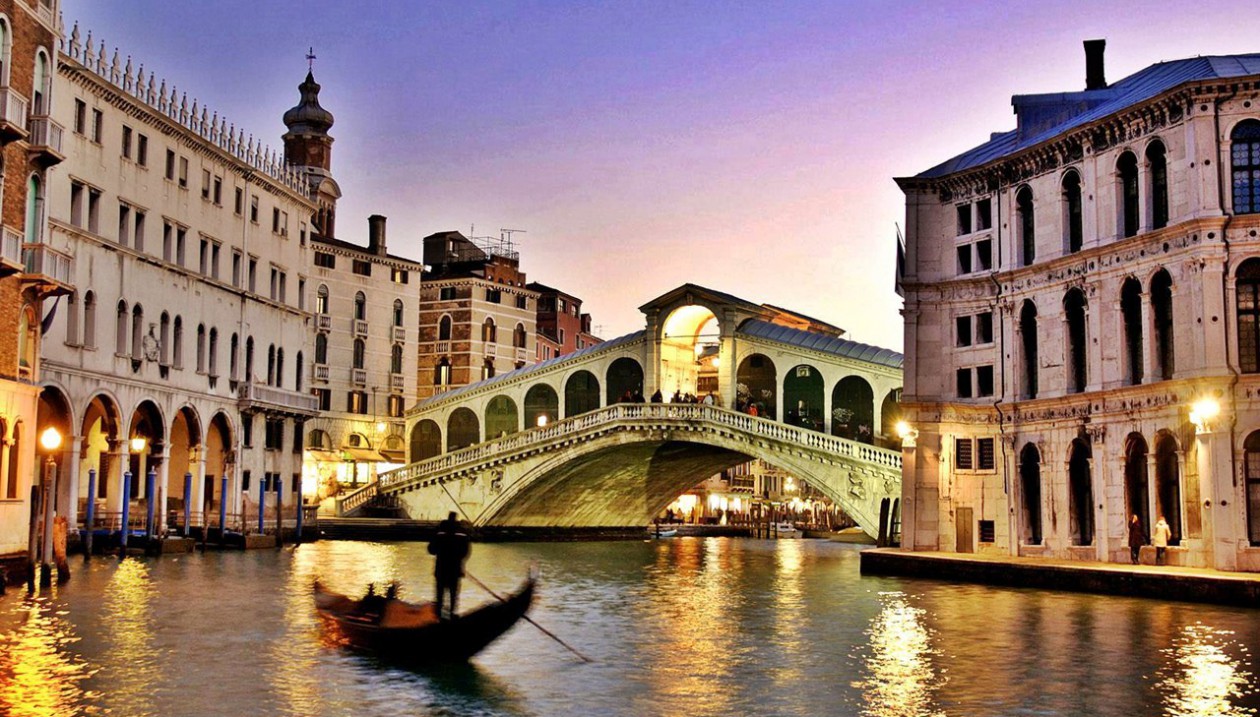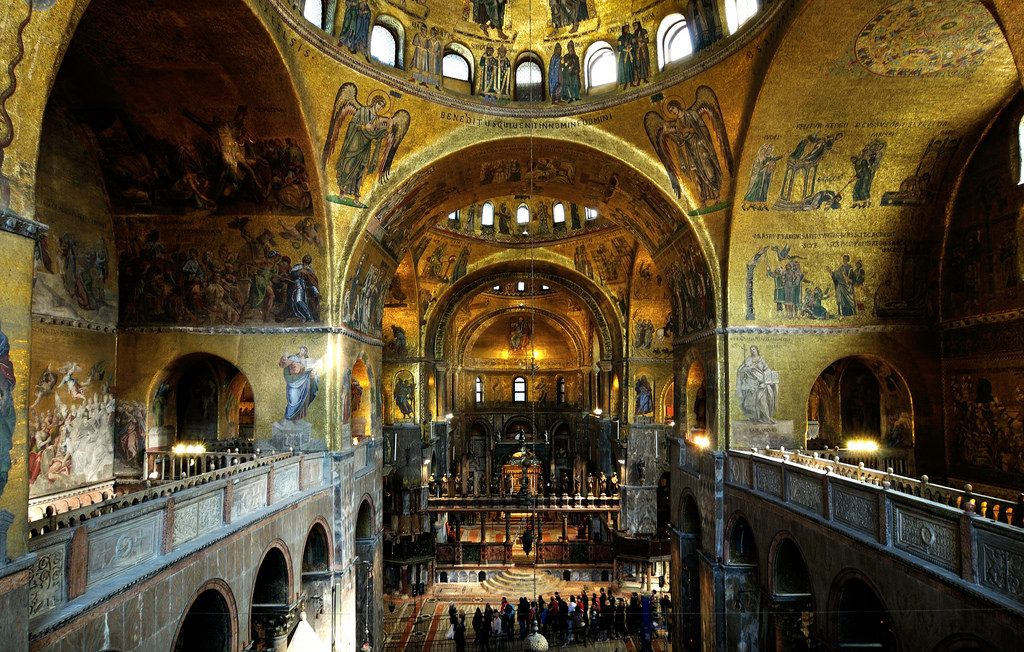Here are five classic romantic stops for your Venice bucket list. Truth be told friends, this is not off the beaten path, but they are traditional sites in Venice that you must experience, particularly if it’s your first time. For second and third times and beyond, it’s a bit like Paris that way – who doesn’t love a gondola ride and the architecture of St. Mark’s Church? For romantic moments, take in the experience very deeply in each and every spot.
Grand Canal
Getting a gondola will remain a highlight from my time in Venice — it is for a lot of people as it has such a long lasting memory. It’s beautiful, romantic and unique — imagine sailing down the fantastic grand canal, a must do regardless of how touristy it is to do. This is the famous one, though admittedly some of the smaller canals also have their charm. The Canal Grande snakes through the city of Venice in a large S shape, traveling from the Saint Mark Basin on one end to a lagoon near the Santa Lucia rail station on the other. This ancient waterway measures 2.36 long and ranges from 100-300 feet wide. In most places, the canal is approximately 16 feet deep.
Photo credit: helenbbrowngroup.com.
The canal is an ancient waterway, lined with buildings – about 170 in all – that were mostly built from the thirteenth to the eighteenth centuries. Most were constructed by wealthy Venetian families at the time. Foot traffic gathers around three famous bridges that cross the canal: the Rialto Bridge, the Ponte Degli Scalzi, and the Ponte dell’Accademia. A fourth, modern (and controversial) bridge was recently added not far from the Scalzi bridge: the Calatrava Bridge. It is believed that the Grand Canal follows the course of an ancient river. One of the first settlements in the area grew along the canal around the area of the Rialto. By the tenth century, it was a center for trade and a safe, ship-accessible port. Because of this, some of the earliest houses along the canal belonged to merchants who did their business on the seas. By the twelfth and thirteenth centuries, homes along the canal became much more ornate and often included Byzantine-style decoration like elongated arches and large loggias. Today, it is as busy as ever and despite how crowded it is, it’s magical nevertheless – best advice is to go off season to avoid the crowds.
Lido Beach
Noemi and I loved Lido beach — it’s a simple boat crossing to get to it and then a short walk down to the golden sands and strip. This beach also helps you escape the vibe and character of the normal Venice we all know. The Lido, or Venice Lido, is an 11-kilometre long sandbar in Venice and houses about 20,000 residents. Also worth noting is that the Venice Film Festival takes place at the Lido every September.
While it is in theory, an island, locals simply refer to it as ‘the Lido’. It is the narrow strip of land which separates the central part of the Venetian lagoon from the Adriatic Sea. Once just a natural barrier, the Lido is now Venice’s seaside. It’s also the origin of the word ‘lido’ as used in the English-speaking world to describe bathing establishments. It was developed as a seaside resort at the beginning of the twentieth century, and has been popular for beach holidays ever since.
The Lido is Venice, yet not Venice. For residents, it’s a compromise between the practical mainland and the historic city. The atmosphere on the Lido is very different from Venice: there are leafy residential avenues, roads, cars, cyclists and pavements. Out of season it feels ‘normal’, with reasonably-priced shops and restaurants, and locals taking their children for walks. There are lovely views over the lagoon to Venice, and in winter and spring you may be lucky enough, on a clear day, to see the snow-capped summits of the Dolomites behind the city’s towers and rooftops. As summer approaches the big hotels open for the season, streams of beach-goers cross from the lagoon, and there are ice-cream shops on every corner.
Although there is a church with ancient origins on the island, the Lido doesn’t appear much in the history of Venice. Geographically it was a crucial part of the lagoon system which protected Venice, but the Venetians left the island as a long sandy bar, useful for anchoring ships and quartering armies. It is possible that the Lido once had greater significance: traditionally the original chief settlement of the lagoon was Malamocco. A modern settlement of that name sits on the southern part of the Lido, but hazy historical traditions suggest that the original Malamocco was lost to the sea, perhaps even being an Adriatic island.
The most important historical monument that is actually visible is in the north of the island, facing over the lagoon. This is the Chiesa di San Nicolò di Lido. Historically this was an important church. It dates to the eleventh century, and for some time the Venetians claimed it housed the body of St. Nicholas, attempting to ignore the much stronger claims of the people of Bari. It’s rather disappointing nowadays, although it comes alive once a year for the annual Festa della Sensa, a symbolic marriage ceremony between Venice and the waters.
Photo credit: Wikipedia.org.
Piazza San Marco
Piazza San Marco aka St. Mark’s Square, is the principal public square of Venice, Italy, where it is generally known just as “the Piazza”. All other urban spaces in the city are called “campi” St. Mark’s Square is essentially Venice on parade, where everyone comes to see and be seen, and of course feed pigeons. This has been the epicenter of the city since the early days of the Republic, when it was a market as well as the center of civic and religious life. Considered one of the finest squares in the world and certainly Venice’s prime attraction, it is surrounded on three sides by the stately arcades of public buildings and on the fourth, by Basilica di San Marco’s riot of domes and arches and the soaring campanile. No obstruction mars its vast stone-paved expanse, where the only traffic is Venetians, tourists, and the zillions of pigeons.
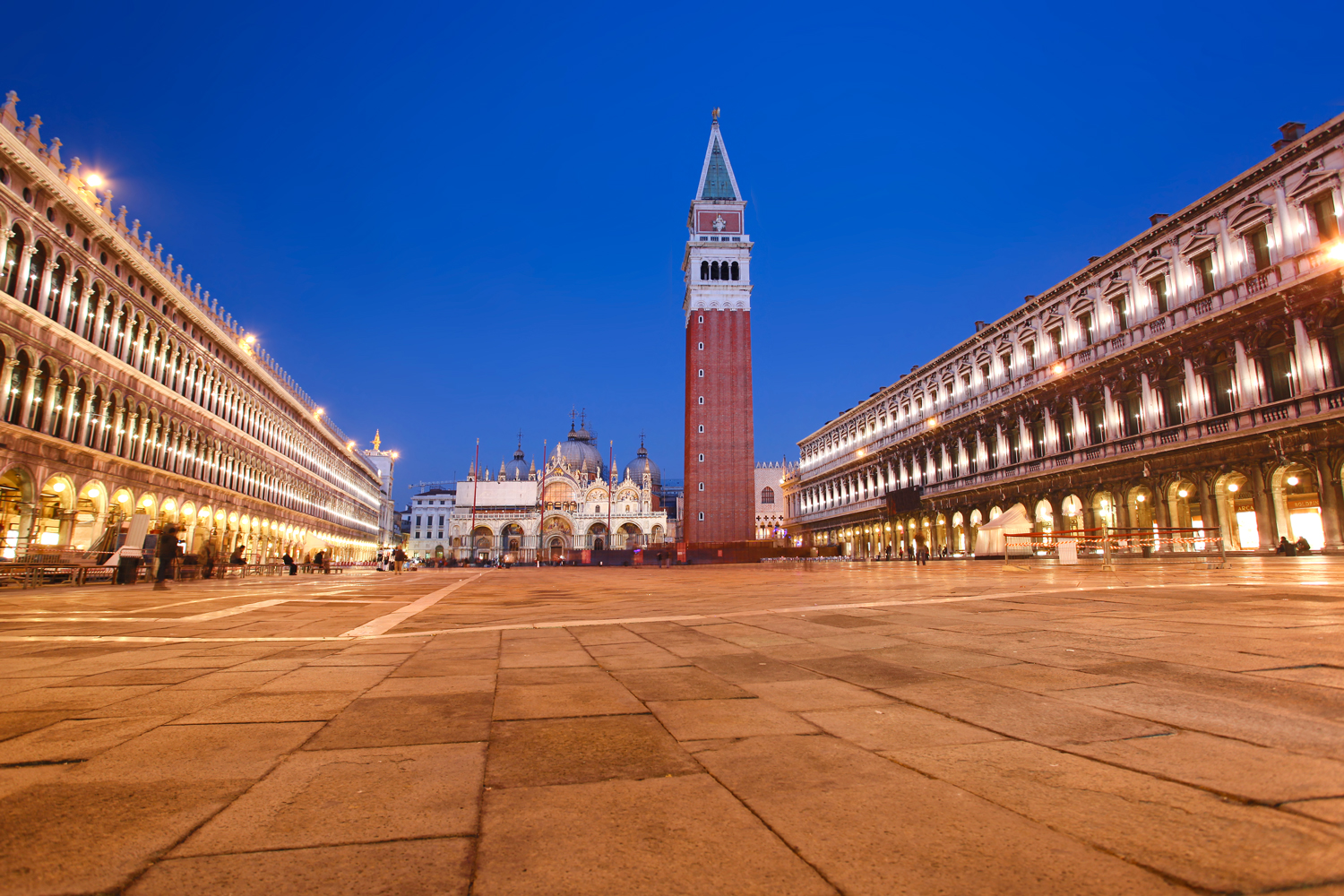
Noemi feeding the pigeons in San Marco Square
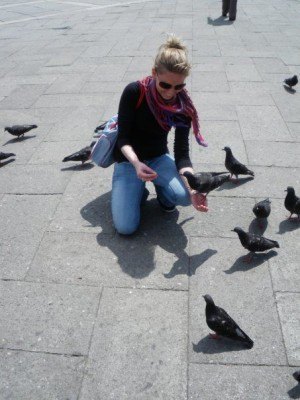
There is excellent music in the cafes nearby, a tres romantic spot for a glass of beer, wine of coffee — a beautiful spot for sunrise or sunset too and for that special kiss.
Rialto Bridge
The Rialto Bridge is one of the four bridges spanning the Grand Canal in Venice, Italy. It is the oldest bridge across the canal, and was the dividing line for the districts of San Marco and San Polo. It’s the city’s most famous of the bridges that cross the Grand Canal (the other two are the Accademia Bridge and the Scalzi). In this area, which originally housed the food market, there has always been a canal crossing, at first, a simple bridge of boats, and later areal wooden bridge, made from two inclined ramps with a mobile section in the middle, in order to allow the passage of ships. The current Rialto Bridge, a stone arch, was constructed under the supervision of Antonio da Ponte, between 1588 and 1591. When Venice was a marine power, that navigated and traded throughout a good part of the modern world, big cargo ships coming from many other countries stopped here in order to unload and sell their merchandise wholesale. Here gathered Venetians, with silk and spices from the Orient, traders from Lombardy and Florence who offered work in metal and textiles, together with Germans and many others coming from other parts of Italy and from across the Alps.
Credit: venicesharetaxi.wordpress.com
The bridge has three walkways: two along the outer balustrades, and a wider central walkway leading between two rows of small shops that sell jewelry, linens, Murano glass, and other items for the tourist trade. (Warning: The bridge consists primarily of steps, making it a challenge for tourists with strollers or wheelchairs.)
Over the centuries, the Ponte di Rialto has earned both praise and scorn from critics. Consider this description from Ian Littlewood’s Venice: A Literary Companion:
“The bridge of the Rialto has had a mixed press. In the judgement of the Venetians, says Moryson, it ‘deserves to be reputed the eighth miracle of the world.’ Coryate, while deploring the ‘vicious and licentious varlets’ who worked the traghetto underneath it, was in agreement–‘the fairest bridge by many degrees for one arch that ever I saw, or heard of.’ But then both Moryson and Coryate were there within a few years of the bridge’s completion. Others have since been less charitable, condemning it as top-heavy and ungraceful. The dispute is academic. Like the Eiffel Tower, the Rialto has acquired a symbolic status that puts it well beyond the reach of aesthetic judgments.”
St. Mark’s Basilica
No visit to southern Europe is complete without checking out a church or cathedral and Italy certainly has no shortage of them. In one of the most Catholic countries in the world, St. Mark’s Basilica is a masterpiece that deserves to be toured. The Patriarchal Cathedral Basilica of Saint Mark is the cathedral church of the Roman Catholic Archdiocese of Venice, northern Italy. It is the most famous of the city’s churches and one of the best known examples of Italo-Byzantine architecture. To build St. Mark’s Church, Venice brought the spiritual and material heritage of Byzantium to the West. The Greek cross plan stands on a structure which in the longitudinal nave has basilica architectural motifs: the vertical arm of the cross is greater than those of the transepts and the altar is in the apse area. Above the cross are five cupolas, according to the eastern model, as a symbol of God’s presence. Organisation of the space is rich in evocations that are not found in other Byzantine churches. The interior has a unitary sequence subdivided into individual spatial orchestrations to which gold background mosaics ensure continuity and the church’s special way of being.
Credit: unknown/flickr.
Also, don’t forget if you visit Venice, you are also close to Italian gems like Trieste (on the Slovenia border), Rimini and San Marino.

Jonny Blair is a self confessed traveling nomad who founded and blogs at Don’t Stop Living. He sees every day as an adventure. Since leaving behind his home town of Bangor in Northern Ireland ten years ago he has traveled to all seven continents, working his way through various jobs and funding it all with hard work and an appetite for travel. Don’t Stop Living, a lifestyle of travel’ contains over 1,000 stories and tips from his journeys round the globe. He wants to show others how easy it is to travel the world, give them some ideas and encourage them to do the same but most of all he aims to constantly live a lifestyle of travel. He is currently based in Hong Kong and on Twitter @jonnyblair.

